Voice-Controlled and Wireless Solid Set Canopy Delivery (VCW-SSCD) System for Mist-Cooling
Abstract
:1. Introduction
2. Materials and Methods
- (1)
- A Solid Set Canopy Delivery (SSCD) system to apply mist and cool down the bud temperature on sunny winter days to enhance chilling.
- (2)
- A Wireless Sensor Network (WSN) and a Weather Station (WS) to collect weather- and crop-related data from the field (several zones).
- (3)
- A Voice-Controlled (VC) system using Amazon Alexa (Amazon Echo) and a server (raspberry pi microcontroller).
- (4)
- A mobile (cellphone) application (Android app) to visualize the collected data and wirelessly control the SSCD system.
- (5)
- A Smart Control (SC) system to collect the data from the WSN, receive commands (wirelessly) from the VC, and (wirelessly) control the SSCD system. The SC system communicates with the mobile app also.
2.1. Solid Set Canopy Delivery (SSCD) System
2.2. Wireless Sensor Network (WSN) and a Weather Station (WS)
- Wireless communication through XBee S2C (Xbee RF Modules, Internation Inc., Minnetonka, MN, USA, 2012) that can transmit 1200 m with an open line of sight; the distance will be reduced with objects obstructing the signal. The XBee is power efficient with transmitting requiring 45 mA, receiving requiring 31 mA, and sleep requiring 1 A. The XBee routers are setup in mesh networking mode extending the network further from the XBee coordinator in the master control unit. Based on [29,30], the tree canopy significantly influences the radio path losses of the WSN; the developed models in [29,30] can be used to estimate the distance between nodes in a WSN in an orchard. This is very critical to scale-up the proposed system.
- A thermistor (temperature sensor) that utilizes the XBee’s onboard analog-to-digital converter to convert the analog voltage read into a digital signal to be sent over ZigBee IEEE 802.15.4 protocol. The thermistor being utilized is a negative temperature coefficient; it operates by decreasing the resistance as the temperature increases and vice versa. The XBee modulation cannot read resistance change of the thermistor, hence a voltage divider was necessary to change the resistance into a voltage. The max voltage read on XBee S2C’s analog ports is 1.2 V, thus a voltage divider is employed to lower the voltage at higher temperatures. The XBee S2C ADC is 10-bit providing a sampling resolution of 0–1023, which allows accurate temperature values to be transmitted. The voltage divider slightly lowers the resolution of temperature data as thermistors are nonlinear. The conversion of thermistors resistance to Kelvin (°K) is done using the simplified parameter Steinhart-Hart (Equation (1)). T is the absolute temperature in °K (it is supplied by the manufacture of the thermistor) and R0 is the resistance at the T0 set by the manufacture. Each thermistor manufacture will supply a thermistor in a tolerance range with coefficients needed for calibration. The thermistors used have a tolerance of 1%, the beta coefficient is 3950, a resistance of 10 k at 25 °C, and an operating range of −55 °C to 125 °C.
2.3. Voice-Controlled (VC) System
2.4. Mobile Application (Android App)
2.5. Smart Control (SC) System
3. Experimental Design
3.1. Farm Test Site
3.2. Experimental Setup
4. Results and Discussion
4.1. Experiment 1
4.2. Experiment 2
4.3. Experiment 3
5. Conclusions
6. Future Research
- The duration of misting (hours/treatment) at different temperatures.
- The intervals between applications to conserve water (hours/days); and determine when evaporative cooling ceases at different temperatures.
- Droplet size for maximum evaporative cooling duration.
- Amount of water applied (volume, ha-cm) per application.
- Volume of mist and energy consumption per treatment and per tree.
- Flower quality evaluation (bloom synchrony, pollen and ovule viabilities).
- Postharvest fruit quality data (tree yields, nuts grading by processing factory).
- Investigate potential salinity and toxicity problems (water, soil, and plant analysis).
Acknowledgments
Author Contributions
Conflicts of Interest
References
- Mall, R.K.; Gupta, A.; Sonkar, G. Effect of climate change on agricultural crops. In Current Developments in Biotechnology and Bioengineering: Crop Modification, Nutrition, and Food Production; Elsevier Science: Amsterdam, The Netherlands, 2016; p. 23. [Google Scholar]
- Otto-Bliesner, B.L.; Brady, E.C.; Fasullo, J.; Jahn, A.; Landrum, L.; Stevenson, S.; Rosenbloom, N.; Mai, A.; Strand, G. Climate variability and change since 850 CE: An ensemble approach with the community earth system model. Bull. Am. Meteorol. Soc. 2016, 97, 735–754. [Google Scholar] [CrossRef]
- Drake, B.L.; Hanson, D.T.; Lowrey, T.K.; Sharp, Z.D. The carbon fertilization effect over a century of anthropogenic CO2 emissions: Higher intracellular CO2 and more drought resistance among invasive and native grass species contrasts with increased water use efficiency for woody plants in the US Southwest. Glob. Chang. Boil. 2017, 23, 782–792. [Google Scholar] [CrossRef] [PubMed]
- Donohue, R.J.; Roderick, M.L.; McVicar, T.R.; Farquhar, G.D. Impact of CO2 fertilization on maximum foliage cover across the globe’s warm, arid environments. Geophys. Res. Lett. 2013, 40, 3031–3035. [Google Scholar] [CrossRef]
- Ainsworth, E.A.; Rogers, A. The response of photosynthesis and stomatal conductance to rising [CO2]: Mechanisms and environmental interactions. Plant Cell Environ. 2007, 30, 258–270. [Google Scholar] [CrossRef] [PubMed]
- Flexas, J.; Carriquí, M.; Coopman, R.E.; Gago, J.; Galmés, J.; Martorell, S.; Morales, F.; Diaz-Espejo, A. Stomatal and mesophyll conductances to CO2 in different plant groups: Underrated factors for predicting leaf photosynthesis responses to climate change? Plant Sci. 2014, 226, 41–48. [Google Scholar] [CrossRef] [PubMed]
- Cal-Adapt: Exploring California’s Climate Change Research. Available online: http://cal-adapt.org (accessed on 18 December 2017).
- California Department of Food and Agriculture. Available online: https://www.cdfa.ca.gov (accessed on 18 December 2017).
- Cox, J. High Rate of Pistachio ‘Blanks’ Worries Local Nut Growers. Available online: http://www.bakersfield.com/news/business/high-rate-of-pistachio-blanks-worries-local-nut-growers/articlen e711c5cb-8532-565e-bc9f-1f3b6807cdaa.html (accessed on 18 December 2017).
- Stiefvater, R. Pistachio grower. Personal communication, 2016. [Google Scholar]
- Ghaemi, A.A.; Rafiee, M.R.; Sepaskhah, A.R. Tree-Temperature Monitoring for Frost Protection of Orchards in Semi-Arid Regions Using Sprinkler Irrigation. Agric. Sci. China 2009, 8, 98–107. [Google Scholar] [CrossRef]
- Hewitt, E.W.; Young, K. Water sprinkling to delay bloom in fruit trees. N. Z. J. Agric. Res. 1980, 23, 37–41. [Google Scholar] [CrossRef]
- Andersen, J.L.; Seeley, B.L. Bloom delay in deciduous fruits. Hortic. Rev. 1993, 15, 97–144. [Google Scholar]
- Tsipouridis, C.; Thomidis, T.; Xatzicharisis, I. Effect of sprinkler irrigation system on air temperatures and use of chemicals to protect cherry and peach trees from early spring frost. Anim. Prod. Sci. 2006, 46, 697–700. [Google Scholar] [CrossRef]
- Playan, E.; Salvador, R.; Faci, J.M.; Zapata, N.; Martinez-Cob, A.; Sanchez, I. Day and night wind drift and evaporation losses in sprinkler solid-sets and moving laterals. Agric. Water Manag. 2005, 76, 39–159. [Google Scholar] [CrossRef] [Green Version]
- Rijal, I.; Flore, J.; Andresen, J. Mist-cooling to delay bloom and prevent frost damage-old idea new technology. In Proceedings of the ASABE 1st Climate Change Symposium: Adaptation and Mitigation Conference Proceedings, Chicago, IL, USA, 3–5 May 2015; American Society of Agricultural and Biological Engineers: St. Joseph, MI, USA; p. 1. [Google Scholar]
- Wolfe, J.W.; Lombard, P.B.; Tabor, M. The effectiveness of a mist versus a low pressure sprinkler system for bloom delay. Trans. ASAE 1976, 19, 510–513. [Google Scholar] [CrossRef]
- Cheng, W.L.; Zhang, W.W.; Chen, H.; Hu, L. Spray cooling and flash evaporation cooling: The current development and application. Renew. Sustain. Energy Rev. 2016, 55, 614–628. [Google Scholar] [CrossRef]
- Baille, M.; Baille, A.; Delmon, D. Microclimate and transpiration of greenhouse rose crops. Agric. For. Meteorol. 1994, 71, 83–97. [Google Scholar] [CrossRef]
- Zapata, N.; Playan, E.; Martinez-Cob, A.; Sanchez, I.; Faci, J.M.; Lecina, S. From on-farm solid-set sprinkler irrigation design to collective irrigation network design in windy areas. Agric. Water Manag. 2007, 87, 187–199. [Google Scholar] [CrossRef]
- Katsoulas, N.; Baille, A.; Kittas, C. Effect of misting on transpiration and conductances of a greenhouse rose canopy. Agric. For. Meteorol. 2001, 106, 233–247. [Google Scholar] [CrossRef]
- Agnello, A.; Landers, A.J. Current progress in the development of a fixed spray pesticide application system for high-density apple plantings. N. Y. Fruit Q. 2006, 14, 22–26. [Google Scholar]
- Lang, G.A. Growing Sweet Cherries under Plastic Covers and Tunnels: Physiological Aspects and Practical Considerations. Proc. Int. Cherry Symp. 2009, 1020, 303–312. [Google Scholar] [CrossRef]
- Sharda, A.; Karkee, M.; Zhang, Q. Fluid dynamics of a solid set canopy spray delivery system for orchard applications. In Proceedings of the American Society of Agricultural and Biological Engineering, Kansas City, MO, USA, 21–24 July 2013. Paper Number 131620688. [Google Scholar]
- Sharda, A.; Karkee, M.; Zhang, Q.; Ewlanow, I.; Adameit, U.; Brunner, J. Effect of emitter type and mounting configuration on spray coverage for solid set canopy delivery system. Comput. Electron. Agric. 2015, 112, 184–192. [Google Scholar] [CrossRef]
- Ampatzidis, Y.; Tan, L.; Haley, R.; Whiting, M.D. Cloud-based harvest management information system for hand-harvested specialty crops. Comput. Electron. Agric. 2016, 122, 161–167. [Google Scholar] [CrossRef]
- Ampatzidis, Y.; Bellis, L.D.; Luvisi, A. iPathology: Robotic applications and management of plants and plant diseases. Sustainability 2017, 9, 1010. [Google Scholar] [CrossRef]
- Luvisi, A.; Ampatzidis, Y.; Bellis, L.D. Plant pathology and information technology: Opportunity and uncertainty in pest management. Sustainability 2016, 8, 831. [Google Scholar] [CrossRef]
- Vougioukas, S.; Anastassiu, H.T.; Regen, C.; Zude, M. Influence of foliage on radio path losses (PLs) for wireless sensor network (WSN) planning in orchards. Biosyst. Eng. 2013, 114, 454–465. [Google Scholar] [CrossRef]
- Anastassiu, H.T.; Vougioukas, S.; Fronimos, T.; Regen, C.; Petrou, L.; Zude, M.; Kathner, J. A Computational Model for Path Loss in Wireless Sensor Networks in Orchard Environments. Sensors 2014, 14, 5118–5135. [Google Scholar] [CrossRef] [PubMed]
- Foster, J. XBee Cookbook; Clark Science Center: Northampton, MA, USA, 2011. [Google Scholar]
- Trudeau, D.; Ward, J.; Zhang, L.; Ferguson, L.; Ampatzidis, Y. Automated solid state canopy delivery (SSCD) system to deliver mist-cooling to increase winter chill for dormancy and bud break. In Proceedings of the ASABE 2017 Annual International Meeting, Spokane, WA, USA, 16–19 July 2017. [Google Scholar]
- Cruz, A.; Luvisi, A.; Bellis, L.D.; Ampatzidis, Y. X-FIDO: An Effective Application for Detecting Olive Quick Decline Syndrome with Deep Learning and Data Fusion. Front. Plant Sci. 2017, 8, 1741. [Google Scholar] [CrossRef] [PubMed]
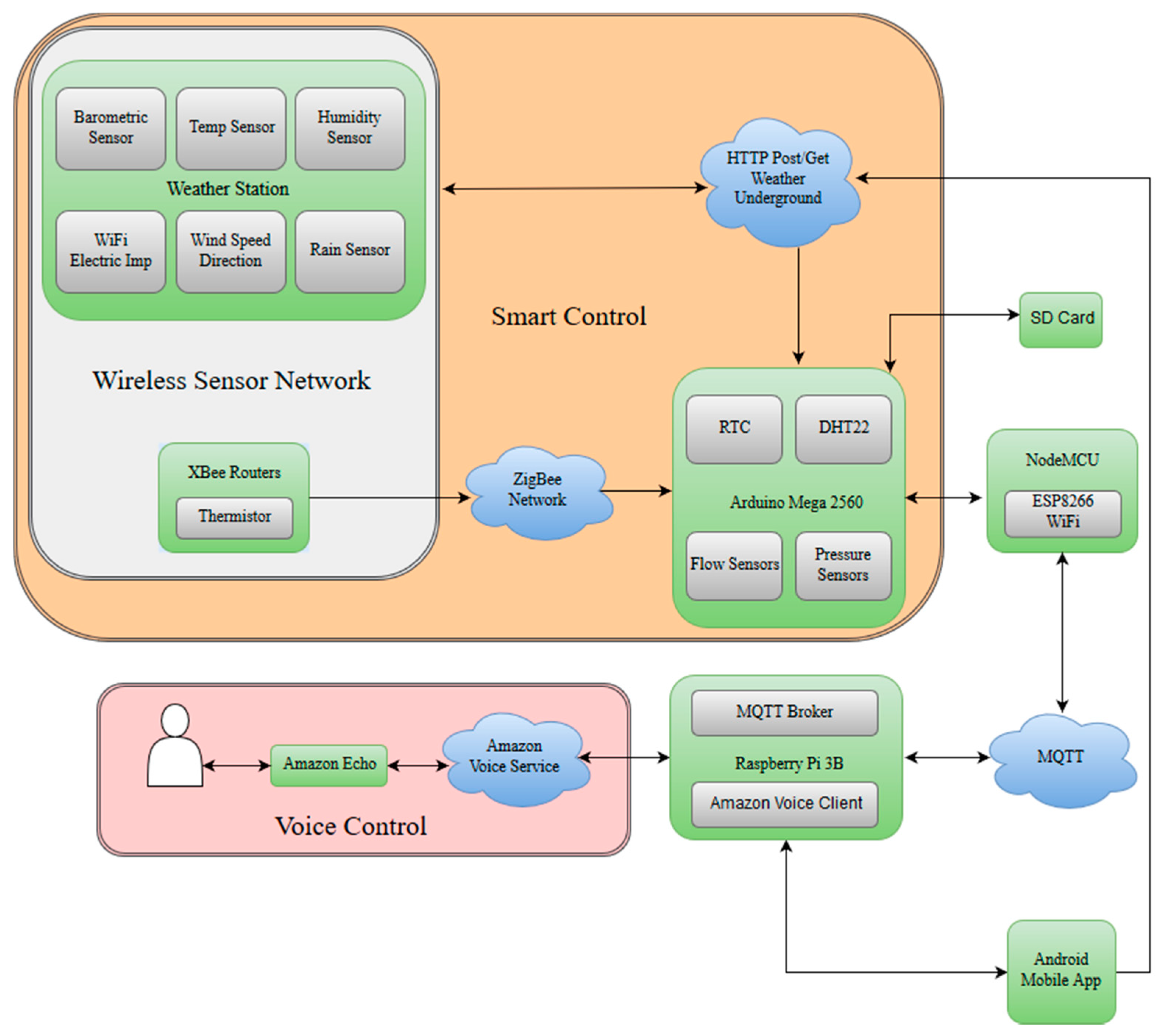


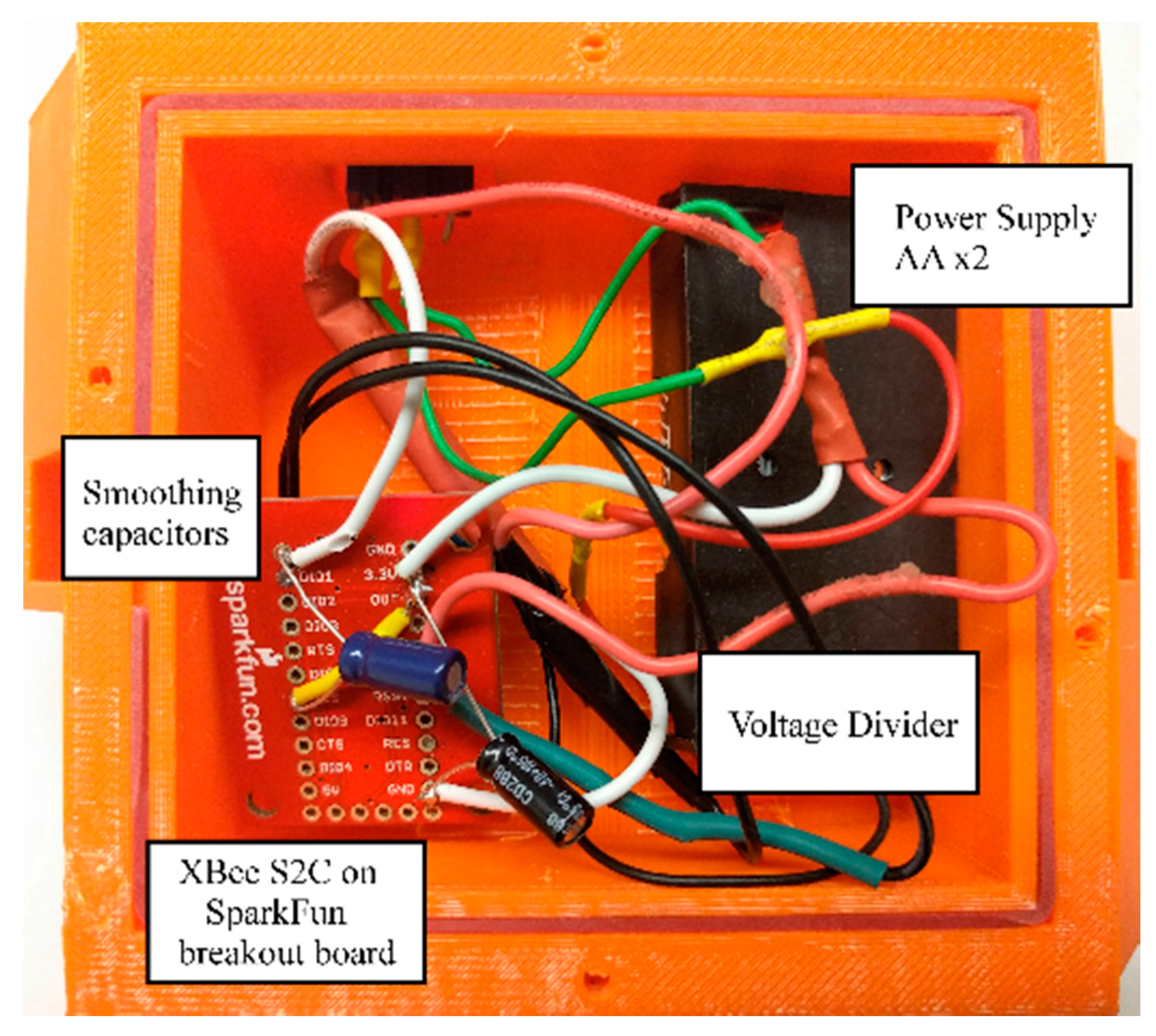

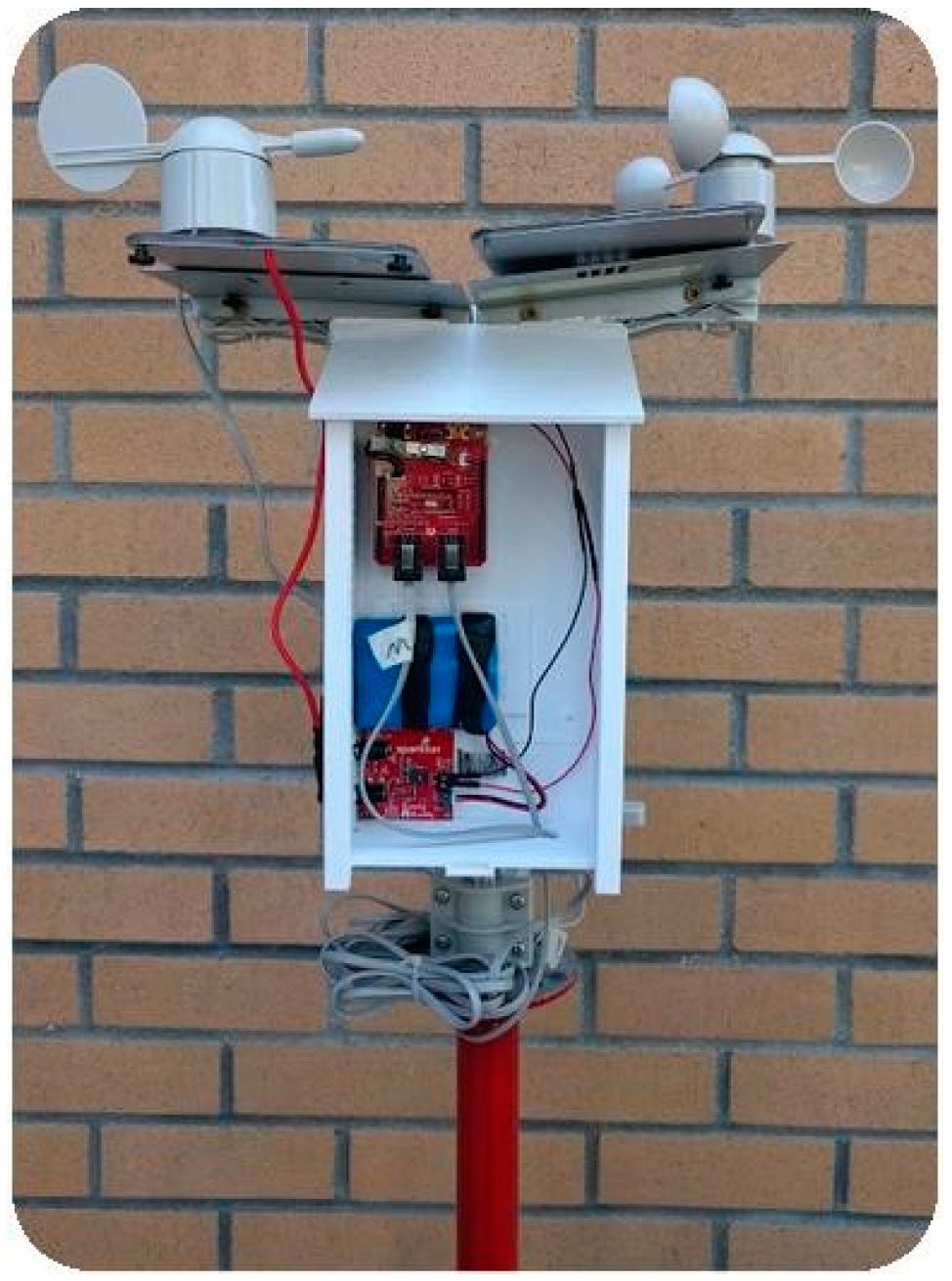


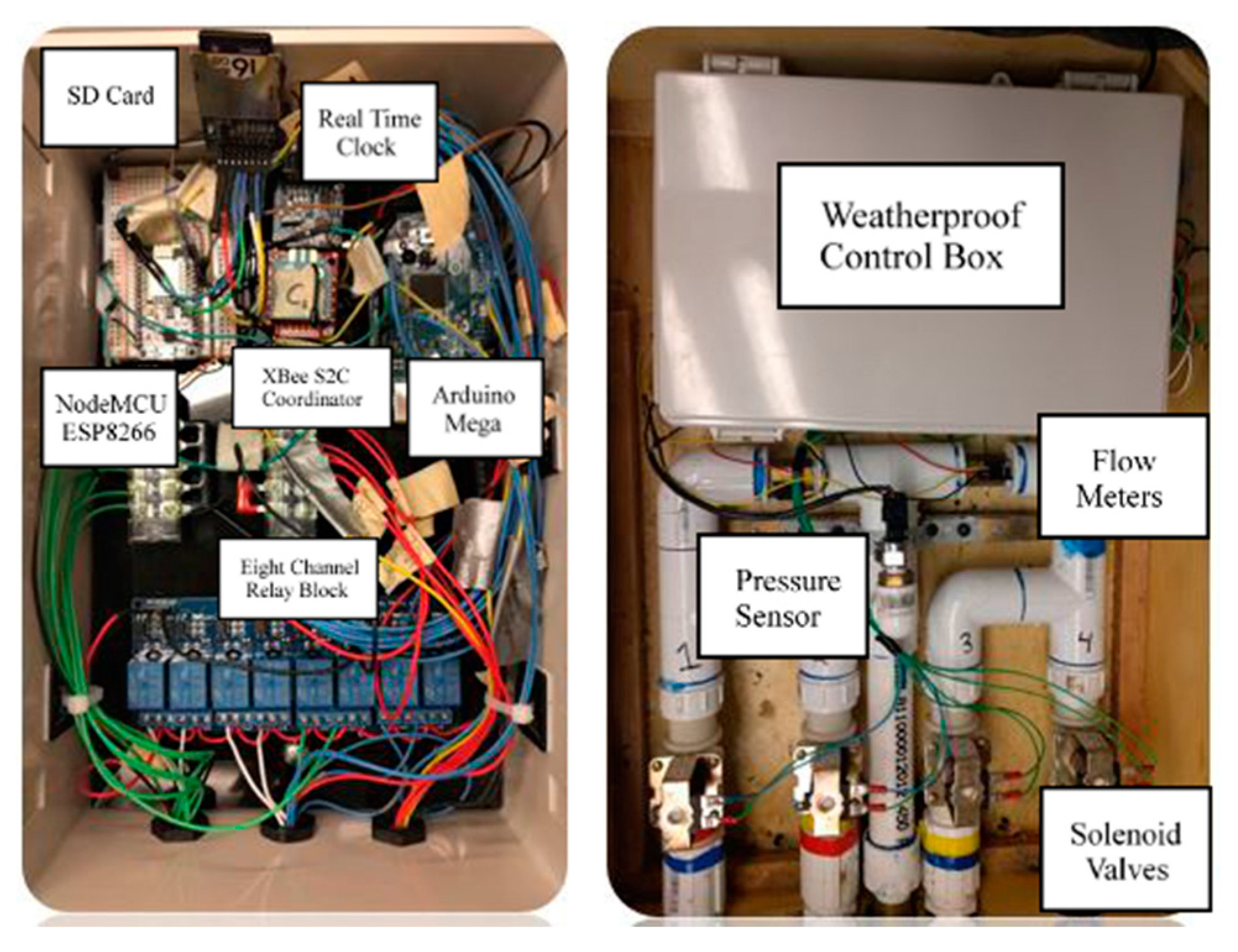
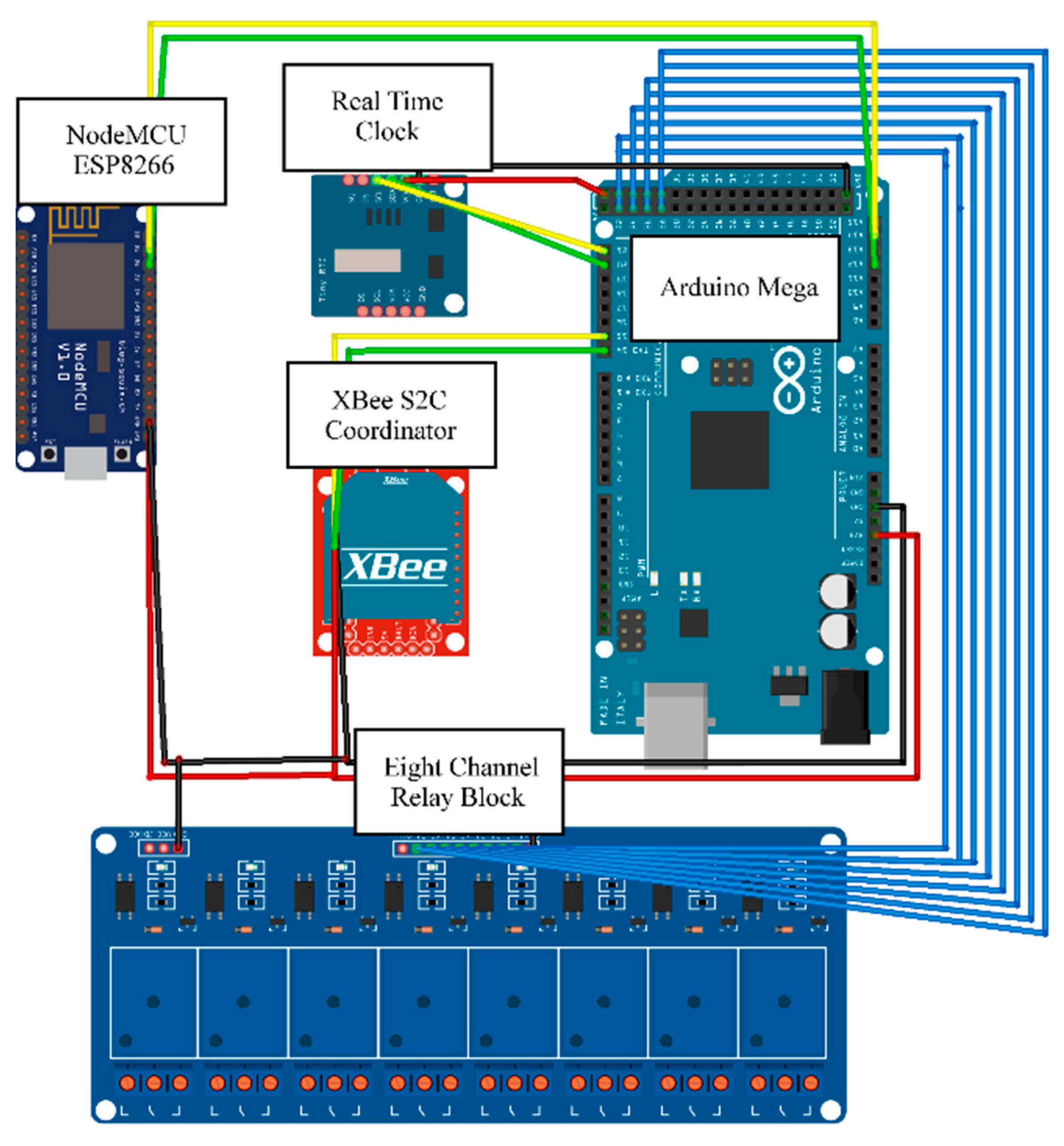
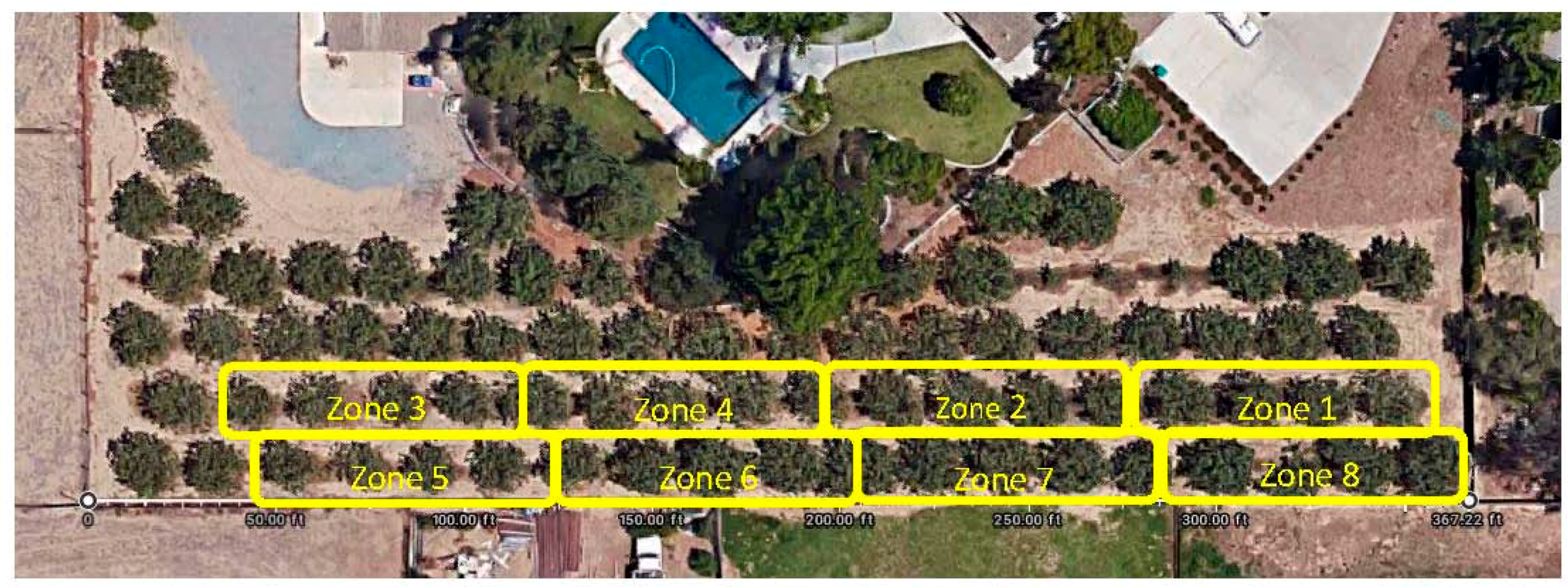
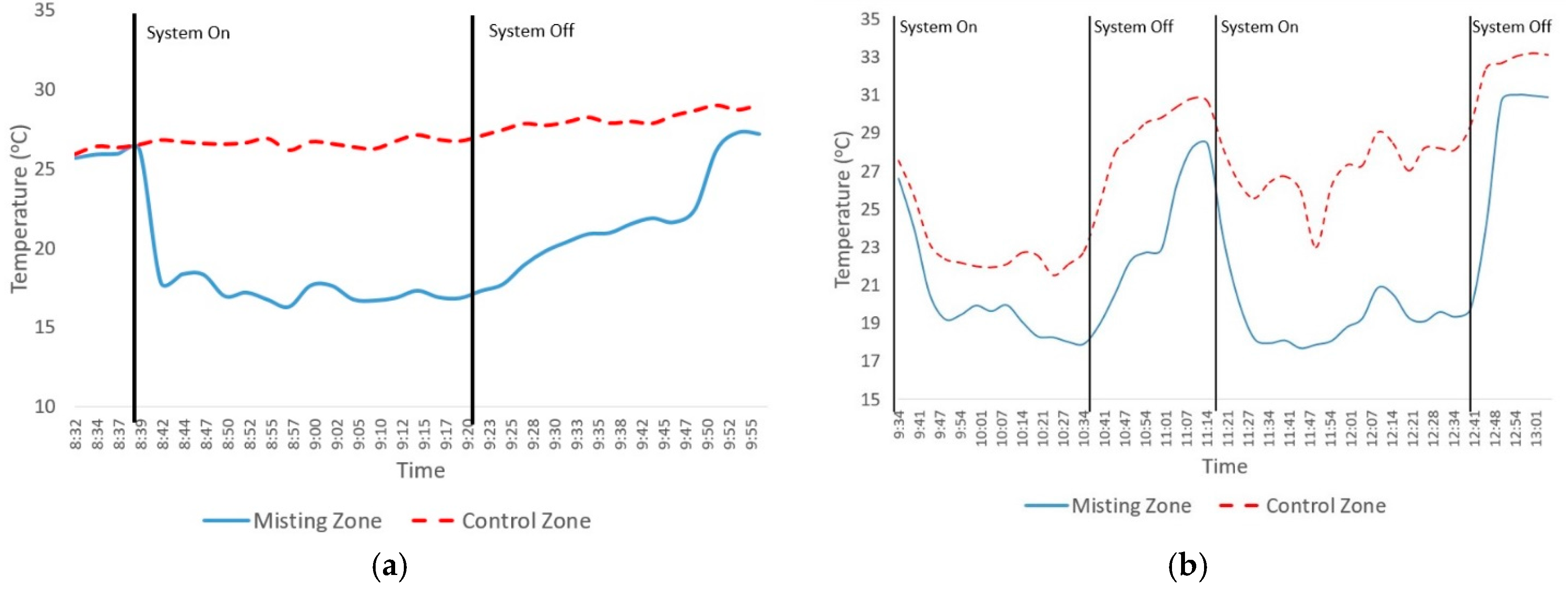
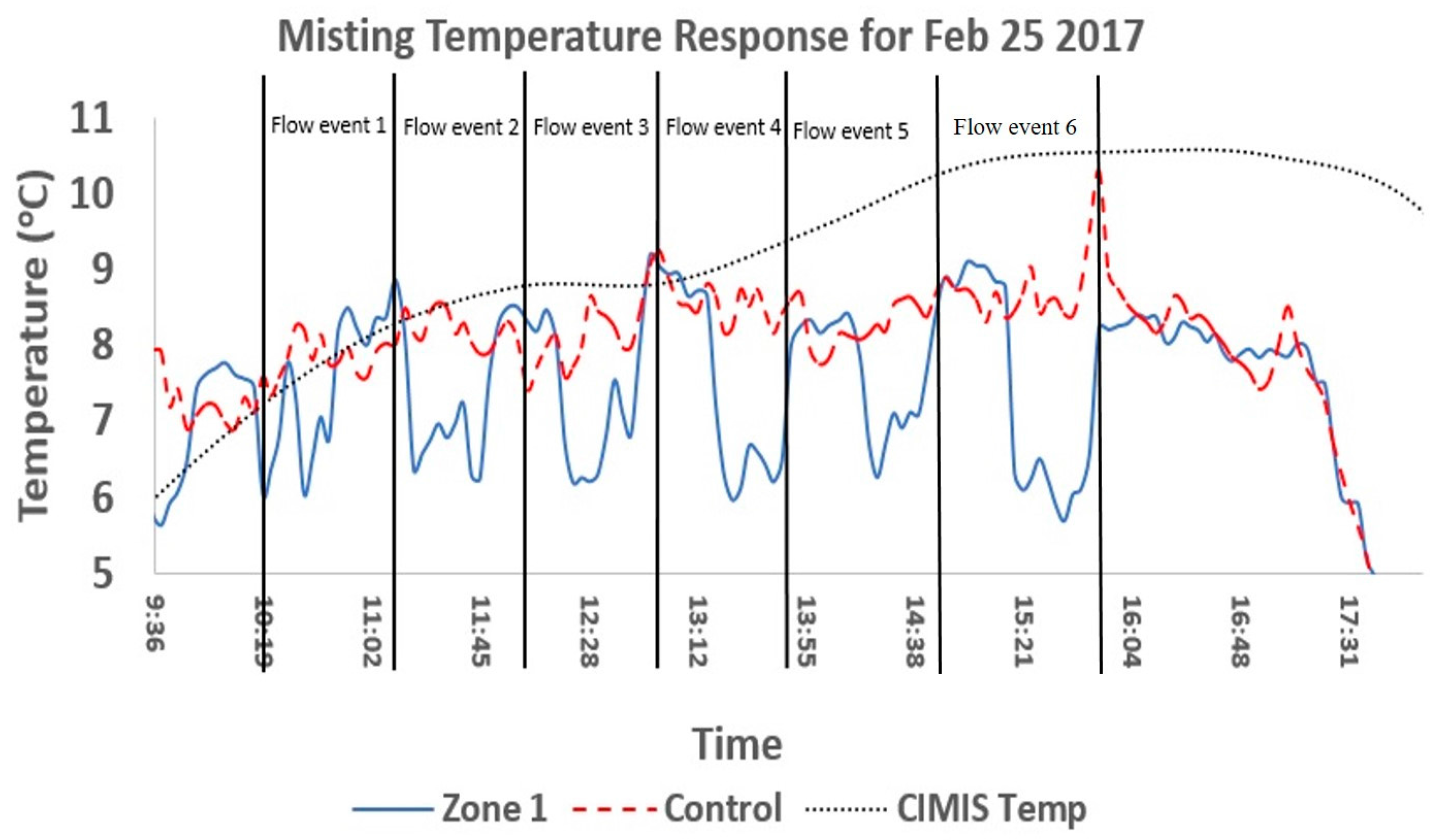
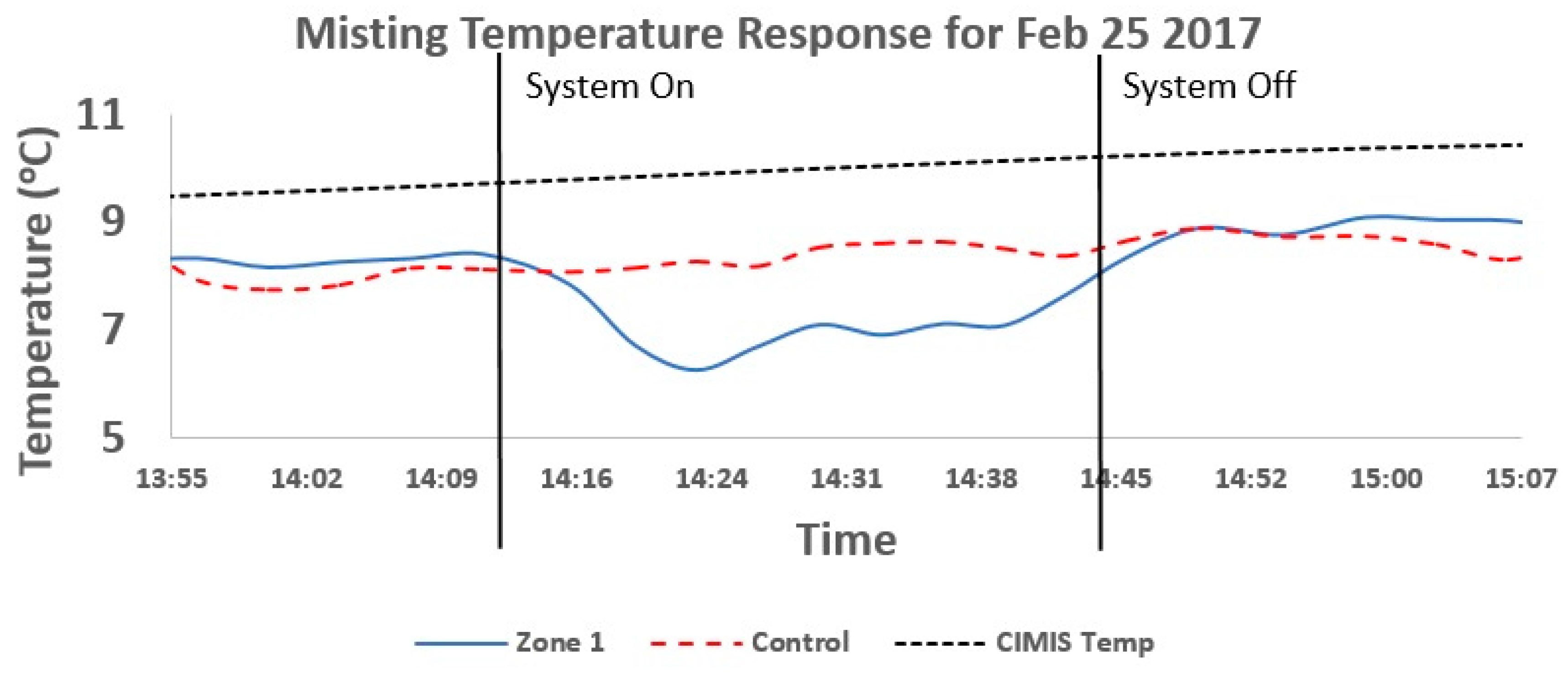
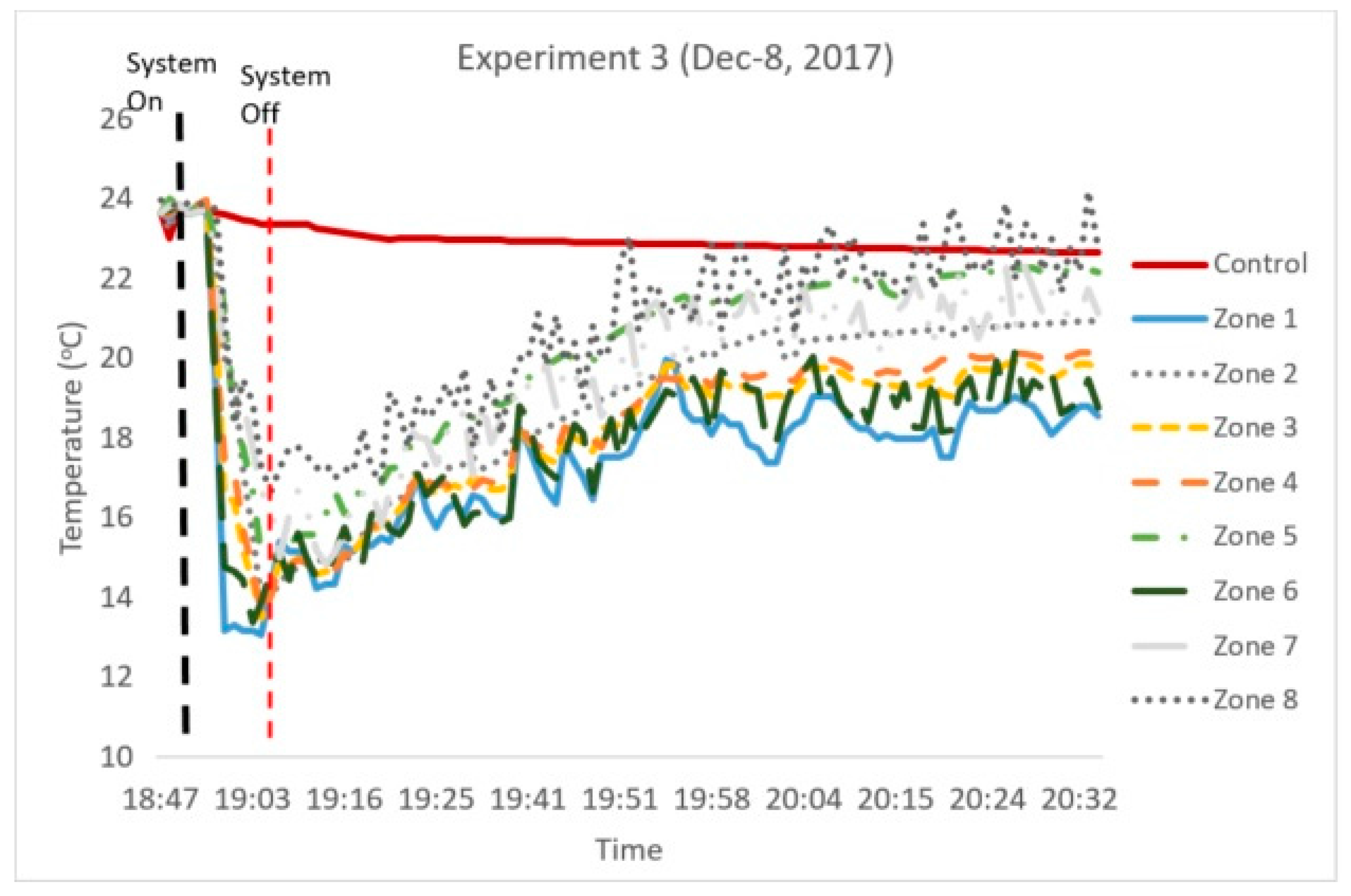
© 2018 by the authors. Licensee MDPI, Basel, Switzerland. This article is an open access article distributed under the terms and conditions of the Creative Commons Attribution (CC BY) license (http://creativecommons.org/licenses/by/4.0/).
Share and Cite
Ampatzidis, Y.; Kiner, J.; Abdolee, R.; Ferguson, L. Voice-Controlled and Wireless Solid Set Canopy Delivery (VCW-SSCD) System for Mist-Cooling. Sustainability 2018, 10, 421. https://doi.org/10.3390/su10020421
Ampatzidis Y, Kiner J, Abdolee R, Ferguson L. Voice-Controlled and Wireless Solid Set Canopy Delivery (VCW-SSCD) System for Mist-Cooling. Sustainability. 2018; 10(2):421. https://doi.org/10.3390/su10020421
Chicago/Turabian StyleAmpatzidis, Yiannis, Josh Kiner, Reza Abdolee, and Louise Ferguson. 2018. "Voice-Controlled and Wireless Solid Set Canopy Delivery (VCW-SSCD) System for Mist-Cooling" Sustainability 10, no. 2: 421. https://doi.org/10.3390/su10020421





